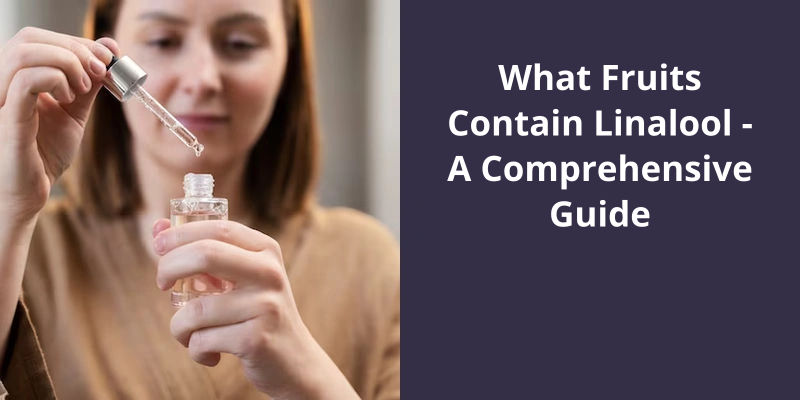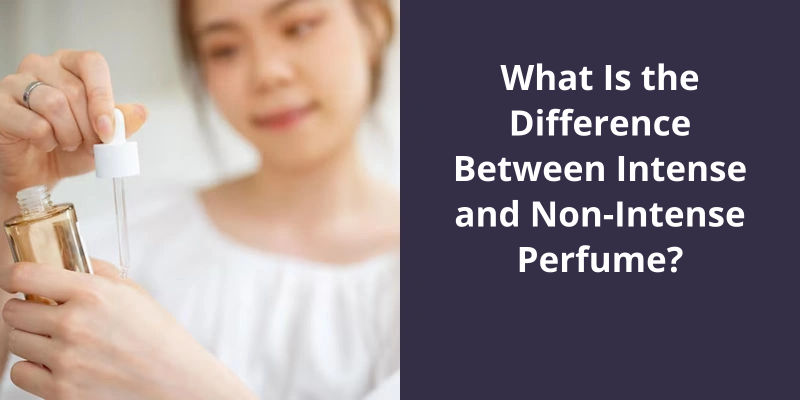Linalool, a naturally occurring alcohol found in a variety of plant sources, is also present in certain fruits. Fruits like mangoes and citrus fruits, such as oranges and lemons, contain this compound. It is also found in smaller amounts in strawberries, plums, and pineapples. The linalool is responsible for many of the flavor and scent qualities of these fruits and has been studied for various potential health benefits as well.

What Fruits and Vegetables Contain Linalool?
Linalool is a naturally-occurring monoterpene alcohol that’s found in a number of different fruits and vegetables. It’s known for it’s pleasant floral aroma and is commonly used in the fragrance and cosmetics industries. While linalool is found in a variety of different foods and spices, there are a few that are particularly rich sources of this compound.
One of the most common sources of linalool is the family of citrus fruits, including oranges, lemons, limes, and grapefruits. These fruits aren’t only rich in vitamin C, but also contain numerous other beneficial compounds, including linalool.
When it comes to vegetables, common thyme is one of the richest sources of linalool. This herb is commonly used in Mediterranean cuisine, particularly in dishes like marinades, soups, and stews. Another herb that contains linalool is basil, which is often used to flavor Italian and Southeast Asian dishes. Coriander, or cilantro, is another spice that contains linalool and is commonly used in Mexican, Indian, and Vietnamese cuisine.
Finally, blackcurrants are a lesser-known but still important source of linalool. These small, tart berries are known for their high levels of vitamin C and antioxidants, and are often used in jams, jellies, and syrups. While linalool may not be the primary reason people choose to eat these fruits and vegetables, it’s still an important component of their overall nutritional profile.
Other Foods and Plants That Contain Linalool, Such as Lavender, Rosewood, and Cinnamon
- Lavender
- Rosewood
- Cinnamon
Now that we know which herbs are high in linalool, it’s important to understand the benefits of this aromatic terpene. Linalool has been found to have anti-inflammatory, analgesic, sedative and anti-anxiety properties, making it a valuable addition to many herbal remedies and natural health products. In this article, we’ll explore the wide range of uses and benefits of linalool, including it’s potential as a natural remedy for a variety of health conditions.
What Herbs Are High in Linalool?
Linalool is a naturally occurring terpene that’s commonly found in many herbs and plants. It’s known for it’s pleasant, floral aroma and is often used in perfumes and aromatherapy. Lavender, bergamot, and sweet basil are some of the herbs that are high in linalool. In addition to it’s use in aromatherapy, linalool has been found to have several health benefits.
Studies have shown that linalool can have a calming effect on the nervous system, reducing the symptoms of anxiety and stress.
Linalool has also been found to have anti-inflammatory properties. It can help reduce pain and swelling, making it a potential treatment for conditions such as arthritis.
Aside from it’s medicinal properties, linalool is also commonly found in cannabis strains. In fact, it’s one of the most abundant terpenes in cannabis.
While linalool is generally considered safe for use, some individuals may be allergic to it. It’s always important to check with a healthcare provider before using any herbal supplement or essential oil, especially if you’ve any underlying health conditions or are taking medication.
It’s several health benefits, including it’s ability to reduce anxiety, reduce inflammation, and fight infections.
How Linalool Is Extracted and Used in Perfumes and Other Products
- Linalool is extracted from various sources such as rosewood, coriander, and lavender.
- It’s primarily used as a fragrance ingredient in perfumes, lotions, and cosmetics.
- Linalool is also used in aromatherapy as a natural stress reliever.
- In addition to it’s fragrance and aromatherapy uses, linalool has shown potential as an anti-inflammatory and pain reliever.
- However, linalool can cause skin irritation in some individuals and should be used with caution.
Source: Linalool
Many aromatherapy enthusiasts prize linalool for it’s calming scent and potential therapeutic effects. This organic compound is found naturally in several plants, including the Cajenne rosewood, Brazil rosewood, Mexican linaloe, Shiu, and coriander seeds. However, it can also be created artificially by several techniques. Let’s explore the uses and benefits of linalool in more detail.
What Plants Are Linalool Found In?
Linalool is a terpenoid alcohol that’s widely used in various industries, including cosmetics, fragrances, and medicine. This naturally occurring compound can be found in numerous plant species, each of which is renowned for it’s unique properties and characteristics.
One of the primary plant sources of linalool is the Cajenne rosewood, also referred to as Brazilian rosewood. This rare and expensive wood is highly prized for it’s sweet, woody aroma and is utilized extensively in perfumery. Additionally, Mexican linaloe – or linalool oil – is obtained from the wood of the tree of the same name. This oil is used extensively in aromatherapy due to it’s calming and relaxing properties.
Another plant species in which linalool can be found is Shiu, which is a tall shrub or small tree that grows natively in Japan, Korea and China. The leaves of this plant are harvested and distilled to yield an essential oil that’s used in perfumes and colognes.
Coriander seeds are yet another source of natural linalool. This herb is widely utilized both as a culinary herb and as a spice. It’s aromatic properties make it a popular ingredient in numerous dishes, particularly those from Middle Eastern and North African cuisine.
While these plants are largely from the aromatic species, linalool is also found in other plant species such as lavender. The oil extracted from the lavender plant contains around 30% linalool, which makes it one of the commonly used sources of this compound. Lavender’s fresh floral scent has led to it being the popular choice in perfumes, cosmetics, and aromatherapy products.
The unique properties of these plants make them valuable sources of linalool for various industries and purposes.
The Benefits of Linalool in Medicine and Health
Linalool is a naturally occurring terpene found in various plant species, including lavender and cannabis. It’s known for it’s pleasant aroma and has been used in aromatherapy for it’s relaxing properties. However, recent studies have shown that linalool possesses various therapeutic benefits, including anti-inflammatory, analgesic, and anti-cancer properties. It’s also been shown to improve cognitive function and reduce anxiety and depression. Linalool shows promising potential for use in medicine and health, and future research may lead to it’s incorporation in various treatments.
Peppermint oil is a popular essential oil known for it’s uplifting and refreshing qualities. But does it contain linalool? Linalool is a commonly found aromatic substance in various plant extracts, including peppermint. However, the concentration of linalool in peppermint oil may vary depending on the plant source and extraction method used. In this article, we’ll explore the role of linalool in peppermint oil and it’s potential benefits.
Does Peppermint Oil Contain Linalool?
Peppermint oil is known to be one of the most versatile essential oils, and it’s derived from the peppermint plant. The oil is commonly used for aromatherapy purposes due to it’s refreshing and energizing scent. Along with it’s pleasant fragrance, peppermint oil has numerous therapeutic properties, such as antimicrobial and anti-inflammatory effects. However, the question remains, does peppermint oil contain linalool?
Linalool is a naturally occurring organic compound that’s present in several plant species. It’s often found in lavender and lavandin essential oils, as well as in woodland pine and peppermint. Menthol is responsible for the cooling sensation that peppermint oil provides and is present in much higher concentrations than linalool.
The amount of linalool in peppermint oil can vary based on the plant species, the harvesting period, and the extraction method used.
So, if you’re looking for a natural solution to boost your well-being, peppermint oil is an excellent choice.
If you suffer from a linalool allergy, it’s important to take precautions to avoid any negative reactions. One way to do this is to steer clear of products that contain the parent allergen, limonene or linalool. This information can usually be found on the label or insert of the product. Additionally, it’s recommended to use perfume- and fragrance-free products as a safer alternative, and to avoid products labeled simply as “parfum”. Furthermore, it’s important to be aware of hydroperoxides of limonene and linalool and take steps to avoid them too.
What to Avoid With a Linalool Allergy?
If you’ve a linalool allergy, there are certain precautions you need to take to ensure that you don’t expose yourself to the allergen. Linalool is a fragrant substance that’s commonly used in perfumes, cosmetics, and other personal care products. It’s also found in many plants, including lavender, rosewood, and cinnamon. This makes it difficult to completely avoid for anyone with an allergy to this substance.
Another substance that people with linalool allergies need to be aware of is hydroperoxides of limonene and linalool. These are chemical compounds that are created when linalool and limonene are exposed to oxygen. These compounds are known to cause allergies and skin irritation, making them a concern for people with allergies.
To avoid exposure to hydroperoxides of limonene and linalool, you should avoid using products that contain these substances. This may mean that you need to avoid some personal care products, such as shampoos and conditioners, that are known to contain these compounds. You should also be cautious when using cleaning products and other household items that may contain these substances.
One of the best ways to do this is to use a fragrance-free product.
Lastly, you should make sure that you read the product labels carefully and only use products that are labeled as safe for people with allergies. You should also be cautious when using new products and always test a small area of skin before using a product on a larger area of skin. This can help you avoid potential allergic reactions and skin irritation.
Alternative Natural Fragrances That People With Linalool Allergies Can Use.
- Vanilla
- Mint
- Basil
- Ginger
- Citrus
- Lavender (in small doses)
- Peppermint
- Cedarwood
- Clove
- Rosemary
Conclusion
In conclusion, linalool isn’t only found in essential oils but also in various fruits. The list ranges from tropical fruits such as guava and pineapple to stone fruits like peaches and plums and even includes passionfruit. This natural compound adds not only a pleasant aroma but also potential health benefits to these fruits. As we continue to learn about the properties of linalool, it's exciting to consider the possibilities for it’s use in the world of food and nutrition.





